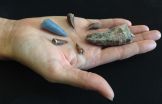(Press-News.org) The BRAF inhibitor dabrafenib has significant anti-tumour activity in patients with advanced BRAF V600E mutant non-small cell lung cancer whose disease has progressed after chemotherapy, according to phase II data presented at the ESMO 2014 Congress in Madrid, Spain.
"Reports of lung cancers bearing mutations in BRAF have generated considerable interest because these mutations may be associated with increased sensitivity to BRAF tyrosine-kinase inhibiting agents," says lead author Dr David Planchard, pulmonary oncologist at the Gustav-Roussy Cancer Campus, Paris, France.
Planchard says studies suggest that activating BRAF mutations are present in around 2% of lung carcinomas—approximately 80% of which are V600E mutations. The BRAF V600E mutations are frequently associated with shorter disease-free, overall survival, and lower response rates to platinum-based chemotherapy.
This open-label phase II study involves patients with BRAF V600E mutant non-small cell lung cancer, treated with dabrafenib alone (150 mg, twice daily). The primary endpoint is investigator-assessed overall response rate, with secondary endpoints of progression-free survival, duration of response, overall survival, safety and tolerability, and population pharmacokinetics.
Data from the 78 patients enrolled in the study showed an overall response rate of 32% in patients who had already received one or more prior treatments, and a disease control rate of 56% after 12 weeks of treatment.
The median duration of response was 11.8 months, and among the six first-line patients, three of them had partial response to the treatment.
The safety profile with dabrafenib was similar to that observed with previous studies in melanoma, the most common adverse events being fever (36% of patients), asthenia (30%), hyperkeratosis (30%), loss of appetite (29%), nausea (27%), cough (26%), fatigue (26%), and skin papilloma (26%). Cutaneous squamous-cell carcinomas, including keratoacanthoma, were also reported in 18% of patients.
Based on earlier interim efficacy and safety data from this study, dabrafenib received a Breakthrough Therapy designation in lung cancer from the FDA in January this year, Planchard says.
In summary, Planchard says, "These findings establish dabrafenib as an effective treatment option for patients with previously treated advanced BRAF V600E non-small cell lung cancer."
HER2 inhibition shows promise in HER2-positive non-small cell lung cancer
Human epidermal growth factor receptor 2 (HER2) mutations may offer an important treatment target in a subset of patients with non-small cell lung cancer, according to data from a phase II randomised trial of neratinib and temsirolimus, also presented at ESMO 2014 in Madrid.
"HER2 mutated non-small cell lung cancer patients are a small subset of non-small cell lung cancer patients—around 1-2%—but it seems important to inhibit HER2 for these patients," says lead author Dr Benjamin Besse, head of the thoracic cancer unit at Gustave Roussy, Paris, France.
Neratinib inhibits the HER2 receptor while temsirolimus inhibits mTOR, a protein that belongs to the signaling cascade of HER2, Besse says.
In a randomised, two-stage study, 27 patients with advanced, metastatic non-small cell lung cancer whose tumours tested positive for HER2 somatic mutations were randomised either to treatment with oral neratinib (240 mg od continuously) alone, or in combination with intravenous temsirolimus (8 mg/week, dose escalation to 15 mg/week after one three-week cycle if tolerated, at the investigator's discretion).
Preliminary results from stage one of the ongoing study show the combination of neratinib and temsirolimus has a 21% overall response rate in 14 patients, with a median progression-free survival of 4 months.
Researchers did observe more gastrointestinal effects such as diarrhea from combination therapy compared to neratinib alone, but it was not a limiting toxicity and the side effect was managed up front with prophylactic loperamide.
In summary, Besse says, "HER2 mutated non-small cell lung cancer represents a very small number of patients, but it reflects the new face of NSCLC --it is not a single homogeneous disease, but a lot of different molecularly defined subsets of patients with potential 'drugable targets', for which specific strategies should be addressed."
Commenting on the two studies, Dr Fiona Blackhall, medical oncologist and senior lecturer at The Christie NHS Foundation Trust, and Manchester University, Manchester, United Kingdom, says the results reinforce that diagnosis of the molecular subtype of lung cancer is central to identification of more effective treatments.
"Studies of targeted approaches in molecularly defined subsets of non-small cell lung cancer are consistently yielding better response rates and survivals than historical studies conducted in non molecularly selected populations," Blackhall says.
"The principles of precision medicine are proven for non-small cell lung cancer, and now efforts must intensify to ensure equitable access to molecular diagnostics for patients with this disease."
INFORMATION:
Promising results shown with targeted approaches in subsets of non-small cell lung cancer
Dabrafenib anti-tumour activity in BRAF V600E mutation-positive non-small cell lung cancer; HER2 inhibition shows promise in HER2-positive non-small cell lung cancer
2014-09-29
ELSE PRESS RELEASES FROM THIS DATE:
Scientists make droplets move on their own
2014-09-29
Droplets are simple spheres of fluid, not normally considered capable of doing anything on their own. But now researchers have made droplets of alcohol move through water. In the future, such moving droplets may deliver medicines, etc.
To be able to move on your own – to be self-moving – is a feature normally seen in living organisms. But also non-living entities can be self-moving, report researchers from University of Southern Denmark and Institute of Chemical Technology in Prague, Czech Republic.
The researchers have made alcohol droplets move in a life-like way, ...
Avoid skunky beer this Oktoberfest with the help of chemistry
2014-09-29
WASHINGTON, Sept. 29, 2014 — Oktoberfest is here, and that means beer. And there's nothing worse than reaching for a cold one, taking that first sip and realizing your beer's been skunked: chemicals have reacted to form compounds that cause an awful, bitter taste. This week, Reactions explains why beers get skunky, and what you can do to keep your brews from going bad. Learn all about it at http://youtu.be/9i4dHdQzTFg.
INFORMATION:
Subscribe to the series at Reactions YouTube, and follow us on Twitter @ACSreactions to be the first to see our latest videos.
The American ...
Ancient human genome from southern Africa throws light on our origins
2014-09-29
What can DNA from the skeleton of a man who lived 2,330 years ago in the southernmost tip of Africa tell us about ourselves as humans? A great deal when his DNA profile is one of the 'earliest diverged' – oldest in genetic terms – found to-date in a region where modern humans are believed to have originated roughly 200,000 years ago.
The man's maternal DNA, or 'mitochondrial DNA', was sequenced to provide clues to early modern human prehistory and evolution. Mitochondrial DNA provided the first evidence that we all come from Africa, and helps us map a figurative genetic ...
DNA signature found in ice storm babies
2014-09-29
This news release is available in French. Montreal, September 29th, 2014 - The number of days an expectant mother was deprived of electricity during Quebec's Ice Storm (1998) predicts the epigenetic profile of her child, a new study finds.
Scientists from the Douglas Mental Health University Institute and McGill University have detected a distinctive 'signature' in the DNA of children born in the aftermath of the massive Quebec ice storm. Five months after the event, researchers recruited women who had been pregnant during the disaster and assessed their degrees of ...
Who are the men and boys suffering from anorexia?
2014-09-29
A new study by researchers from the University of Montreal reveals the current state of knowledge about anorexia in men and boys. "Most of the knowledge about anorexia pertains to females. However, about 10% of persons affected are males, and we believe this figure is underestimated," says Laurence Corbeil-Serre, lead author of the study. "Our results show that there appear to be similarities between the behavioural symptoms of males and females, but certain particularities can be identified in males, especially related to personality, gender identity, and sexual orientation."
The ...
Researchers show irradiation plus transplantation effective for treating HIV/AIDS
2014-09-29
Yerkes National Primate Research Center researchers are the first to show that an irradiation plus transplantation combination approach in nonhuman primates can be used to treat or even possibly cure HIV/AIDS, and this new model is providing some answers about the "Berlin patient," the only human thought cured of AIDS. The study is published in the September 25 issue of PLOS Pathogens.
Guido Silvestri, MD, division chief of Microbiology and Immunology at the Yerkes Research Center at Emory, and several of his research colleagues performed the first hematopoietic stem ...
Tooth buried in bone shows prehistoric predators tangled across land, sea
2014-09-29
About 210 million years ago when the supercontinent of Pangea was starting to break up and dog-sized dinosaurs were hiding from nearly everything, entirely different kinds of reptiles called phytosaurs and rauisuchids were at the top of the food chain.
It was widely believed the two top predators didn't interact much as the former was king of the water, and the latter ruled the land. But those ideas are changing, thanks largely to the contents of a single bone.
In a paper published online in September in the German journal Naturwissenschaften, Stephanie Drumheller of ...
Simulations reveal an unusual death for ancient stars
2014-09-29
Certain primordial stars—those 55,000 and 56,000 times the mass of our Sun, or solar masses—may have died unusually. In death, these objects—among the Universe's first-generation of stars—would have exploded as supernovae and burned completely, leaving no remnant black hole behind.
Astrophysicists at the University of California, Santa Cruz (UCSC) and the University of Minnesota came to this conclusion after running a number of supercomputer simulations at the Department of Energy's (DOE's) National Energy Research Scientific Computing Center (NERSC) and Minnesota Supercomputing ...
Myriad presents tumor BRACAnalysis CDx study at ESMO
2014-09-29
SALT LAKE CITY, Utah, Sept. 29, 2014 – Myriad Genetics, Inc. (Nasdaq: MYGN) today announced that its Tumor BRACAnalysis CDx™ companion diagnostic test significantly improved the detection of cancer-causing BRCA1/2 mutations by 44 percent in women with ovarian cancer. Data from this new study were presented at the 2014 European Society for Medical Oncology (ESMO) annual meeting in Madrid, Spain.
"Several previous clinical studies have demonstrated that patients with germline or somatic BRCA1/2 mutations respond to certain DNA-damaging medicines such as the platinum ...
Cells from placentas safe for patients with multiple sclerosis
2014-09-29
Patients with Multiple Sclerosis (MS) were able to safely tolerate treatment with cells cultured from human placental tissue, according to a study published today in the journal Multiple Sclerosis and Related Disorders. The study, which is the first of its kind, was conducted by researchers at Mount Sinai, Celgene Cellular Therapeutics subsidiary of Celgene Corporation and collaborators at several other institutions.
While designed to determine safety of the treatment, early signals in the data also suggested that a preparation of cultured cells called PDA-001 may repair ...
LAST 30 PRESS RELEASES:
Routine scans could detect early prostate radiotherapy changes
Fairness in AI: Study shows central role of human decision-making
Pandemic ‘beneath the surface’ has been quietly wiping out sea urchins around the world
Tea linked to stronger bones in older women, while coffee may pose risks
School feeding programs lead to modest but meaningful results
Researchers develop AI Tool to identify undiagnosed Alzheimer's cases while reducing disparities
Seaweed based carbon catalyst offers metal free solution for removing antibiotics from water
Simple organic additive supercharges UV treatment of “forever chemical” PFOA
£13m NHS bill for ‘mismanagement’ of menstrual bleeds
The Lancet Psychiatry: Slow tapering plus therapy most effective strategy for stopping antidepressants, finds major meta-analysis
Body image issues in adolescence linked to depression in adulthood
Child sexual exploitation and abuse online surges amid rapid tech change; new tool for preventing abuse unveiled for path forward
Dragon-slaying saints performed green-fingered medieval miracles, new study reveals
New research identifies shared genetic factors between addiction and educational attainment
Epilepsy can lead to earlier deaths in people with intellectual disabilities, study shows
Global study suggests the underlying problems of ECT patients are often ignored
Mapping ‘dark’ regions of the genome illuminates how cells respond to their environment
ECOG-ACRIN and Caris Life Sciences unveil first findings from a multi-year collaboration to advance AI-powered multimodal tools for breast cancer recurrence risk stratification
Satellite data helps UNM researchers map massive rupture of 2025 Myanmar earthquake
Twisting Spins: Florida State University researchers explore chemical boundaries to create new magnetic material
Mayo Clinic researchers find new hope for toughest myeloma through off-the-shelf immunotherapy
Cell-free DNA Could Detect Adverse Events from Immunotherapy
American College of Cardiology announces Fuster Prevention Forum
AAN issues new guideline for the management of functional seizures
Could GLP-1 drugs affect risk of epilepsy for people with diabetes?
New circoviruses discovered in pilot whales and orcas from the North Atlantic
Study finds increase in risk of binge drinking among 12th graders who use 2 or more cannabis products
New paper-based technology could transform cancer drug testing
Opioids: clarifying the concept of safe supply to save lives
New species of tiny pumpkin toadlet discovered in Brazil highlights need for conservation in the mountain forests of Serra do Quiriri
[Press-News.org] Promising results shown with targeted approaches in subsets of non-small cell lung cancerDabrafenib anti-tumour activity in BRAF V600E mutation-positive non-small cell lung cancer; HER2 inhibition shows promise in HER2-positive non-small cell lung cancer



